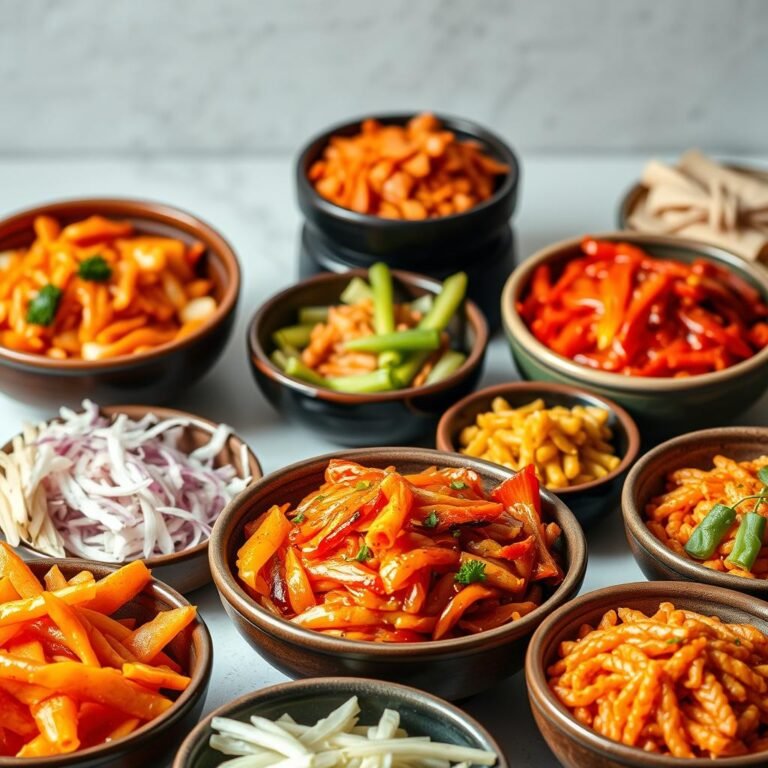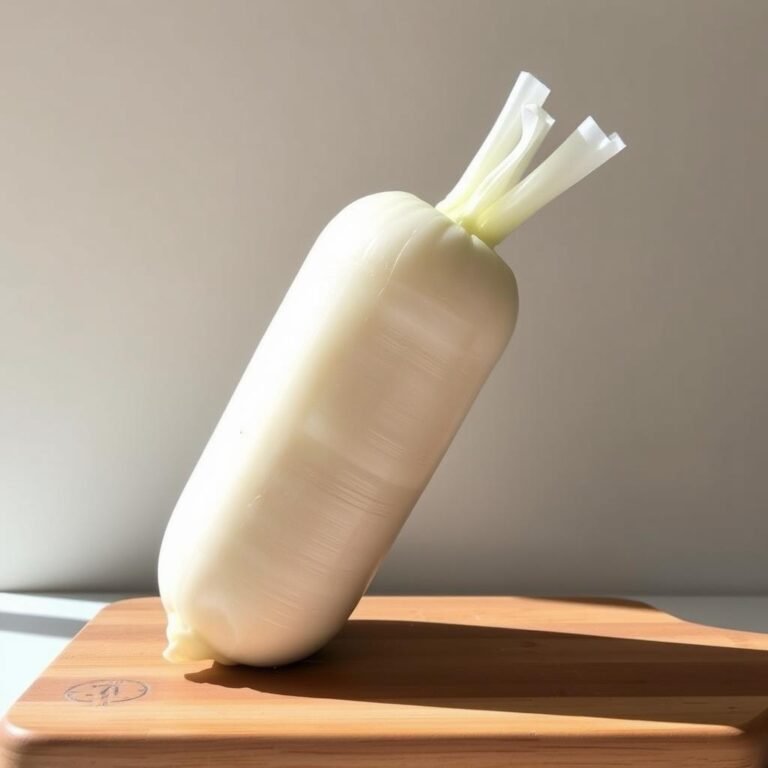Authentic Kimchi Radish Recipe as Home Probiotic
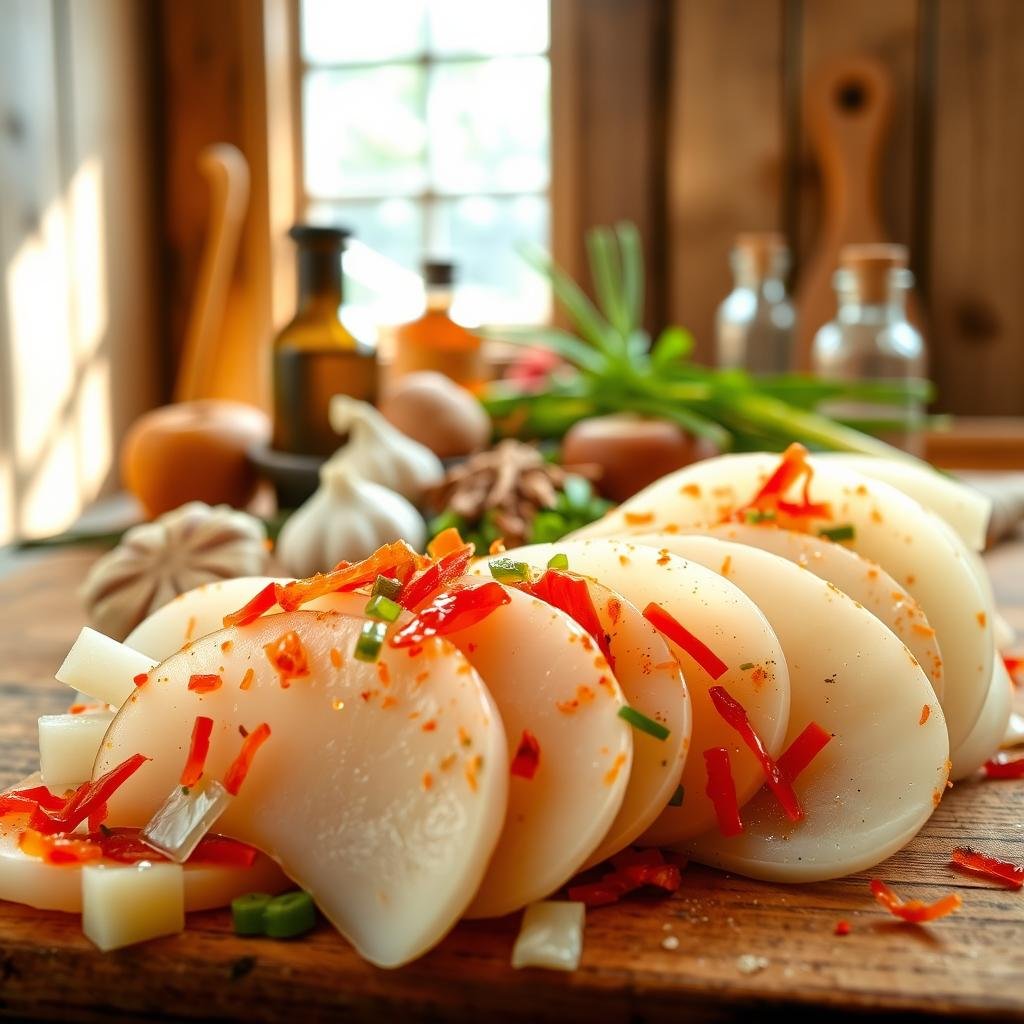
Learn to make kimchi radish at home. It’s a tasty, probiotic-rich side dish that’s good for your gut. You’ll discover how to make this crunchy, tangy treat, full of fermentation’s natural benefits.
By making your own kimchi radish, you can tailor it to your taste. It also gives you a steady supply of probiotics. These support your digestive system in a natural way.
What is Kimchi
Kimchi is a traditional Korean dish. It’s made by fermenting vegetables with spices. This gives it a unique flavor. Korean radish kimchi uses radish instead of cabbage for a twist.
Health Benefits of Kimchi
Kimchi is full of vitamins A and C. It’s good for your immune system, skin, and heart. The fermentation process makes it taste better and adds more probiotics.
The Role of Probiotics
Probiotics in kimchi, like Lactobacillus, keep your gut healthy. They help with digestion and boost your immunity. Eating kimchi regularly can make you feel better overall.
| Key Nutrients | Kimchi Health Benefits |
|---|---|
| Vitamin A | Boosts immune function, supports vision |
| Vitamin C | Strengthens the immune system, promotes skin health |
| Probiotics | Improves digestion, enhances gut health |
Adding Korean radish kimchi to your diet can be tasty and healthy.
Ingredients Needed for Kimchi Radish
To make tasty kimchi radish at home, start by getting the right ingredients for kimchi. This fermented dish is a key part of Korean food. It adds a burst of flavor with every bite. Here’s a list of key and optional Korean cooking ingredients, plus the tools you’ll need.
Essential Ingredients
The main ingredients for kimchi radish are:
- Korean radish or daikon: The main ingredient, making it crunchy.
- Gochugaru (Korean chili flakes): Adds heat and color.
- Garlic: Brings a strong aroma.
- Ginger: Adds a spicy kick.
- Fish sauce: Adds depth of umami.
- Scallions: Adds freshness and taste.
Optional Ingredients for Variation
For those wanting to try new things, add these extra Korean cooking ingredients:
- Apple or pear: Adds sweetness and depth.
- Sugar: Helps with fermentation and balances spice.
- Salt: Important for brining and keeping it fresh.
- Seafood (like shrimp paste): Increases umami and flavor.
Tools and Utensils Required
For easy kimchi making, you’ll need these kimchi preparation tools:
- Large mixing bowl: For mixing all ingredients well.
- Food processor: Important for making the kimchi paste.
- Airtight fermentation containers: Needed for fermentation without contamination.
Preparing the Radish
Preparing the radish is key when making kimchi. It sets the stage for delicious, fermented kimchi. Follow these steps for the best results.
Choosing the Right Radish
Choose a firm, fresh Korean radish, or mu. Daikon is a good substitute if mu is not found. The radish should be clean and heavy, showing it’s full of water. This water is vital for fermentation.
Cleaning and Peeling the Radish
Cleaning the radish is important to get rid of dirt and pesticides. Start by rinsing it under cold water. Then, use a vegetable brush for a deep clean. After that, peel the radish with a vegetable peeler. This removes the tough, bitter outer skin.
Cutting Techniques for Uniform Fermentation
How you cut the radish affects the kimchi’s texture and taste. Cut it into 1-inch cubes for even fermentation. This ensures the seasoning spreads evenly and fermentation happens the same in every piece.
Making the Kimchi Paste
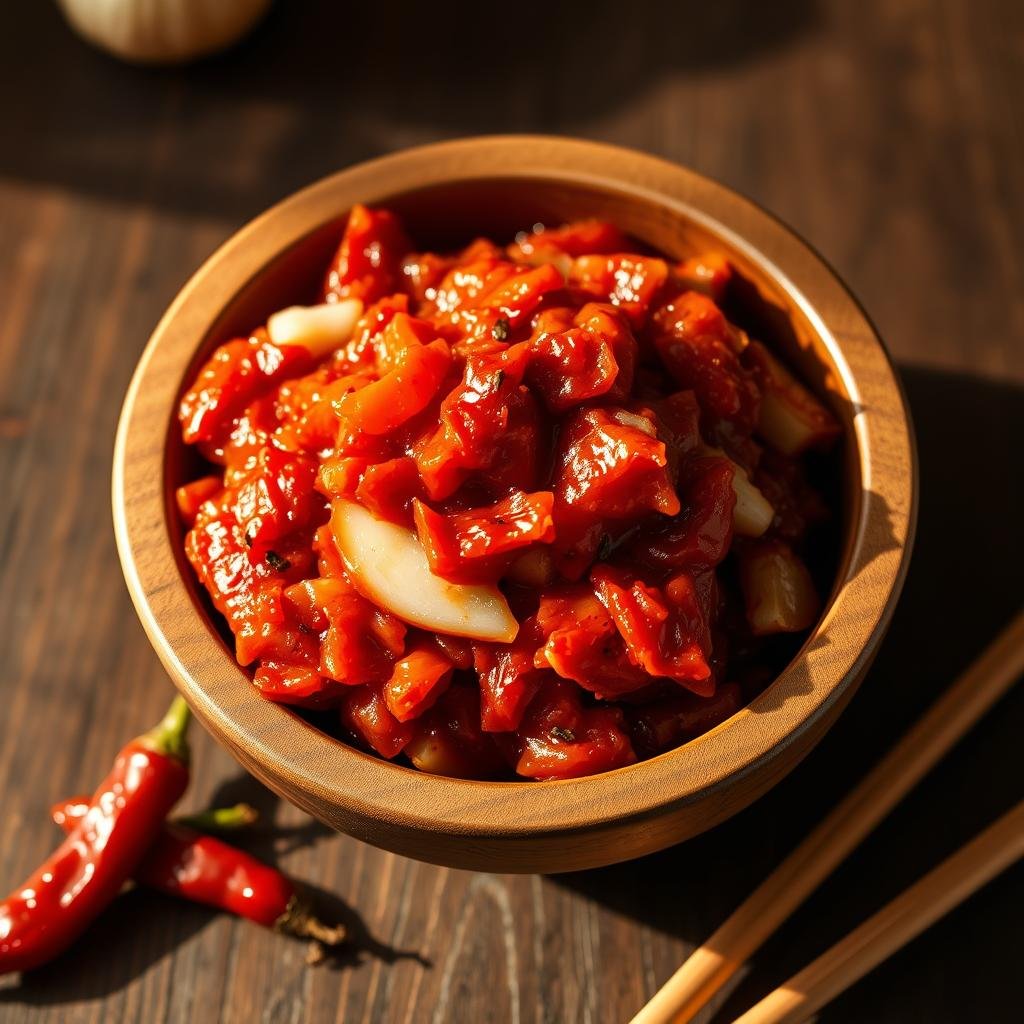
Making the perfect kimchi paste is key to great flavor and heat. We’ll cover the main ingredients, how to prepare it, and how to tweak it to your liking.
Key Ingredients for the Paste
A traditional kimchi paste has gochugaru, garlic, ginger, fish sauce, and sometimes apple or pear. Each part adds spice, umami, and sweetness, blending well together.
Step-by-Step Paste Preparation
- In a bowl, mix 1 cup of gochugaru, 10 minced garlic cloves, 1 thumb-sized piece of grated ginger, and 2-3 tablespoons of fish sauce.
- Add half an apple or pear for sweetness and mix well.
- Keep mixing until it’s smooth and even.
Adjusting Flavors to Your Preference
Want to make kimchi paste just right for you? You can change the spice level by adjusting the gochugaru. For sweetness, add more fruit. For a savory taste, add more fish sauce or salt. Try different amounts to find your perfect kimchi paste.
Combining Radish and Kimchi Paste
Mixing kimchi radish and paste needs some key techniques. It’s important to coat each radish piece evenly with the paste. This is key for a great kimchi seasoning process. Let’s explore how to mix radish and kimchi paste well.
Proper Mixing Techniques
For the best results, use your hands to mix the paste with radish slices. This hands-on method helps control the mixing. It makes sure the paste covers every part of the radish.
Ensuring Even Coating
Even coating is very important in the kimchi seasoning process. Add the paste a little at a time to avoid clumps. If needed, break the radish and paste into smaller parts. This makes it easier to coat each piece well.
Tips for Avoiding Over Mixing
Don’t overmix, as it can make your kimchi mushy. Mix just until the radish is evenly coated. Too much mixing can ruin the crunchy texture you want. Follow these tips to keep your radish crisp and well-seasoned.
Fermentation Process

Fermenting kimchi radish needs careful attention to get the best results. It starts with choosing the right place for fermentation.
Ideal Fermentation Conditions
The best place for fermenting kimchi radish is cool and dark. It should be around 65°F (18°C). Keeping it clean and away from air helps the good bacteria grow.
Duration of Fermentation
The time it takes to ferment kimchi can vary. It depends on what you like and the environment. First, let it sit at room temperature for three days. Then, put it in the fridge to slow it down and get a deeper flavor over 14 days.
Signs of Proper Fermentation
Knowing when your kimchi is fermenting right is key. Look for bubbles, a tangy smell, and a lively taste. These signs of kimchi fermentation mean your radish is becoming tasty.
Storing Your Kimchi Radish
Keeping your kimchi radish fresh is key. Follow these tips to keep it tasty for months.
Best Storage Practices
Always use an airtight container for storing kimchi radish. This stops air from spoiling it. Keep it in the fridge for slow fermentation and better taste.
Watch for mold, bad smells, or slime. Check more on fermentation here.
How to Preserve Freshness
To keep kimchi freshness, don’t disturb it much. Opening the container lets air in, which can harm it. Use small portions in separate containers to reduce air exposure.
Press the kimchi down to keep it in its juice. This creates a safe environment against bad stuff.
Freezing Kimchi Radish: Pros and Cons
Freezing kimchi radish is a storage option. But, it changes the texture and taste. The radish gets softer after thawing.
Thaw it slowly in the fridge and eat it within weeks. Freezing is best when other ways can’t be used.
Serving Suggestions
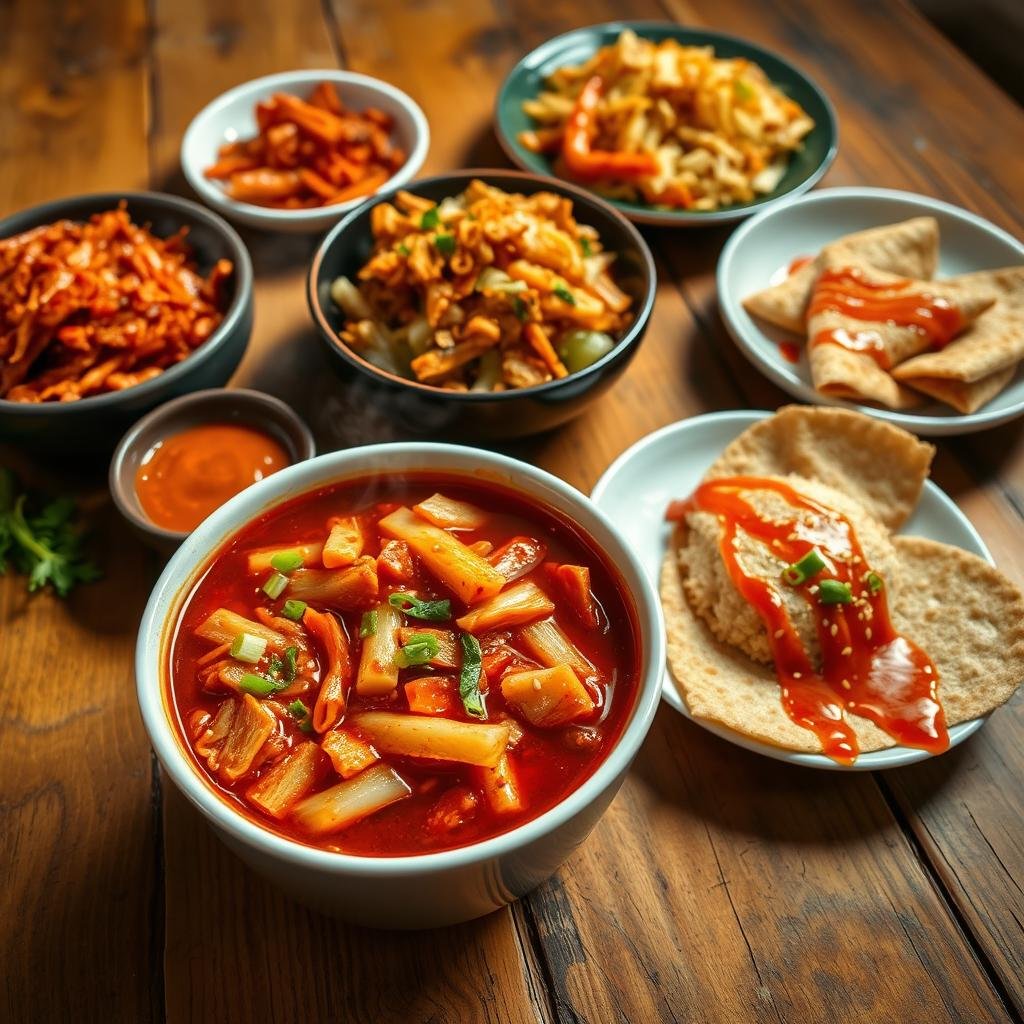
Kimchi radish is a great addition to your meals. Learning how to serve kimchi opens up new flavors. It’s perfect as a side dish with Korean meals like bulgogi and bibimbap. It adds a spicy kick.
One fun way to serve it is with mozzarella cheese. This mix of flavors is amazing.
Try new kimchi dish pairings for creative meals. Add it to soups for a fermented twist. Or top your burger for an exotic touch.
Breakfast lovers can add a fried egg. This makes a simple dish into a hearty meal.
When using kimchi in recipes, be bold. Mix it into Western salads for a unique taste. Crushed roasted seaweed adds a salty crunch.
For more ideas, check out this page. With kimchi, your cooking options are endless.
Nutritional Information
Kimchi radish is packed with nutrients. It’s tasty, tangy, and spicy. Let’s explore why it’s so good for you.
Breakdown of Key Nutrients
Kimchi radish is full of vitamins and minerals. It has lots of vitamin C, vitamin A, and potassium. These help your immune system, eyes, and keep your body balanced.
Caloric Content
Kimchi radish is low in calories. A serving has about 23 calories. It’s great for those watching their calories but want tasty food.
Health Insights
Kimchi is more than just good for you. It’s made through fermentation, which makes nutrients better. It also has probiotics that help your gut.
These probiotics improve digestion and lower cholesterol. Eating kimchi regularly can also help your heart. It’s full of fiber and antioxidants.
Troubleshooting Common Issues
When making kimchi, you might face some challenges. These can affect the quality and safety of your batch. Knowing how to fix these problems is key to a successful fermentation.
Common Fermentation Problems
Poor fermentation often comes from wrong salt levels. Too little salt slows down fermentation, while too much stops good bacteria. Also, too much moisture can cause mold. It’s important to get the salt and moisture just right for good fermentation.
For more on why kimchi might be slimy and how to fix it, see this guide.
Addressing Taste and Texture Issues
If your kimchi tastes or feels off, you can make changes. The time it ferments affects its taste. If it’s too warm for too long, it might not taste good.
Adjust the seasonings by adding or taking away garlic, ginger, and sugar. This can improve the flavor.
What to Do with Failed Batches
Even if a batch doesn’t turn out right, it’s not a total loss. You can use it in soups, stews, or fried rice. If it’s too salty or sour, rinse it and mix with fresh veggies.
Being creative with it can turn a failed batch into something new and tasty.

